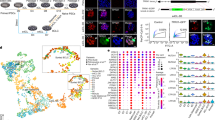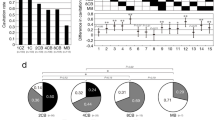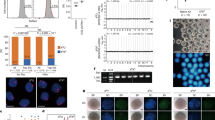Abstract
It has been suggested that the failure of parthenogenetic mouse embryos to develop to term is primarily due to their aberrant cytoplasm and homozygosity leading to the expression of recessive lethal genes1. The reported birth of homozygous gynogenetic (male pronucleus removed from egg after fertilization) mice and of animals following transplantation of nuclei from parthenogenetic embryos to enucleated fertilized eggs2,3, is indicative of abnormal cytoplasm and not an abnormal genotype of the activated eggs. However, we4 and others5,6 have been unable to obtain such homozygous mice. We investigated this problem further by using reconstituted heterozygous eggs, with haploid parthenogenetic eggs as recipients for a male or female pronucleus. We report here that the eggs which receive a male pronucleus develop to term but those with two female pronuclei develop only poorly after implantation. Therefore, the cytoplasm of activated eggs is fully competent to support development to term but not if the genome is entirely of maternal origin. We propose that specific imprinting of the genome occurs during gametogenesis so that the presence of both a male and a female pronucleus is essential in an egg for full-term development. The paternal imprinting of the genome appears necessary for the normal development of the extraembryonic membranes and the trophoblast.
This is a preview of subscription content, access via your institution
Access options
Subscribe to this journal
Receive 51 print issues and online access
$199.00 per year
only $3.90 per issue
Buy this article
- Purchase on Springer Link
- Instant access to full article PDF
Prices may be subject to local taxes which are calculated during checkout
Similar content being viewed by others
References
Graham, C. F. Biol. Rev. 49, 399–422 (1974).
Hoppe, P. C. & Illmensee, K. Proc. natn. Acad. Sci. U.S.A. 74, 5657–5661 (1977).
Hoppe, P. C. & Illmensee, K. Proc. natn. Acad. Sci. U.S.A. 79, 1912–1916 (1982).
Surani, M. A. H. & Barton, S. C. Science 222, 1034–1036 (1983).
Modlinski, J. A. J. Embryol. exp. Morph. 60, 153–161 (1980).
Markert, C. L. J. Hered. 73, 390–397 (1982).
Kaufman, M. H., Barton, S. C. & Surani, M. A. H. Nature 265, 53–55 (1977).
Surani, M. A. H., Barton, S. C. & Kaufman, M. H. Nature 270, 601–603 (1977).
Sawicki, J. A., Magnuson, T. & Epstein, C. J. Nature 294, 450–451 (1981).
West, J. D., Frels, W. I., Chapman, V. M. & Papaioannou, V. E. Cell 12, 873–882 (1977).
Takagi, N., Wake, N. & Sasaki, M. Cytogenet. Cell Genet. 20, 240–248 (1978).
Harper, M. I., Fosten, M. & Monk, M. J. Embryol. exp. Morph. 67, 127–135 (1982).
Endo, S. & Takagi, N. Jap. J. Genet. 56, 349–356 (1981).
Rastan, S., Kaufman, M. H., Handyside, A. H. & Lyon, M. F. Nature 288, 172–173 (1980).
Wakasugi, N. J. Reprod. Fert. 41, 85–96 (1974).
Stevens, L. C. Symp. Soc. dev. Biol. 33, 93–106 (1975).
Iles, S. A., McBurney, M. W., Bramwell, S. R., Deussen, Z. A. & Graham, C. F. J. Embryol. exp. Morph. 34, 387–405 (1975).
Stevens, L. C., Varnum, D. S. & Eicher, E. M. Nature 269, 515–517 (1977).
Whittingham, D. G. & Wales, R. G. Aust. J. biol. Sci. 22, 1065–1072 (1969).
Cuthbertson, K. S. R. J. exp. Zool. 226, 311–314 (1983).
Whittingham, D. G. J. Reprod. Fert. Suppl. 14, 7–21 (1971).
Barton, S. C. & Surani, M. A. H. Expl Cell Res. 146, 187–191 (1983).
McGrath, J. & Solter, D. Science 220, 1300–1302 (1983).
Neff, J. M. & Enders, J. F. Proc. Soc. exp. Biol. Med. 127, 260–271 (1968).
Giles, R. E. & Ruddle, F. H. In Vitro 9, 103–108 (1973).
Graham, C. F. Acta endocr. Suppl. 153, 154–167 (1971).
Chapman, V. M., Whitten, W. K. & Ruddle, F. H. Devl Biol. 26, 153–161 (1971).
Markert, C. L. & Seidel, G. E. in New Technologies in Animal Breeding (eds Brackett, B. G., Seidel, G. E. & Seidel, S. M.) 181–199 (Academic, New York, 1981).
Author information
Authors and Affiliations
Rights and permissions
About this article
Cite this article
Surani, M., Barton, S. & Norris, M. Development of reconstituted mouse eggs suggests imprinting of the genome during gametogenesis. Nature 308, 548–550 (1984). https://doi.org/10.1038/308548a0
Received:
Accepted:
Issue Date:
DOI: https://doi.org/10.1038/308548a0
This article is cited by
-
The role of DNA hydroxymethylation and TET enzymes in placental development and pregnancy outcome
Clinical Epigenetics (2023)
-
Conservation and divergence of canonical and non-canonical imprinting in murids
Genome Biology (2023)
-
Mechanisms and function of de novo DNA methylation in placental development reveals an essential role for DNMT3B
Nature Communications (2023)
-
EpiTyping: analysis of epigenetic aberrations in parental imprinting and X-chromosome inactivation using RNA-seq
Nature Protocols (2023)
-
Emerging evidence that the mammalian sperm epigenome serves as a template for embryo development
Nature Communications (2023)
Comments
By submitting a comment you agree to abide by our Terms and Community Guidelines. If you find something abusive or that does not comply with our terms or guidelines please flag it as inappropriate.



